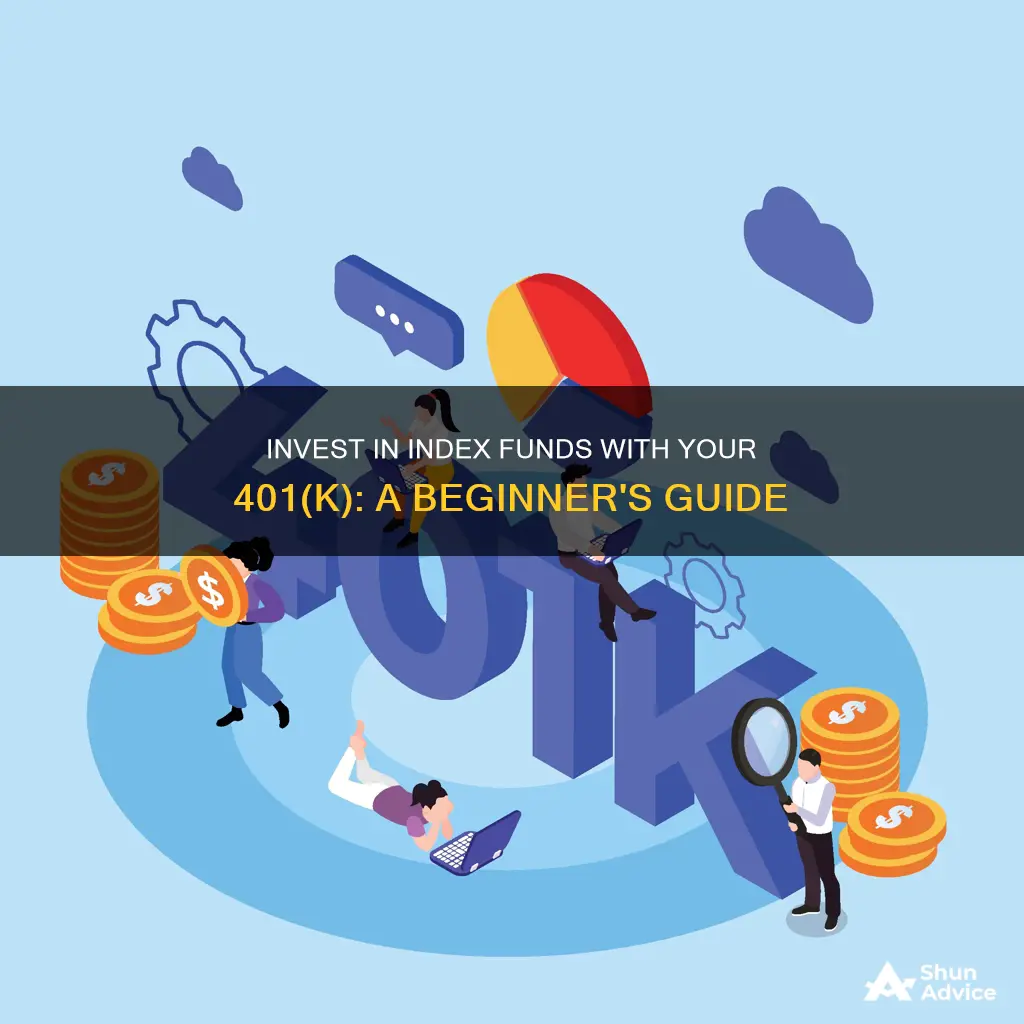
Index funds are a type of hands-off fund that tracks a particular benchmark financial index, such as the S&P 500, Nasdaq, or the Dow Jones Industrial Average. They are designed to mimic the performance of these market indexes. This makes them a passive, low-cost alternative to actively managed funds, which are more common in 401(k) plans. When investing in index funds with a 401(k), it is important to consider factors such as fund expenses, historical performance, and the level of risk involved.
| Characteristics | Values |
|---|---|
| Investment options | Stock mutual funds, bond mutual funds, target-date mutual funds, stable value funds, individual stocks, bonds, ETFs or other mutual funds |
| Investment selection factors | Long-term returns, expense ratio |
| Investment types | Conservative fund, value fund, balanced fund, aggressive growth fund, specialized funds, target-date fund |
| Investment considerations | Risk tolerance, age, retirement funds needed, other sources of income |
| Diversification | Avoid company stock, no more than 10% of portfolio in company stock |
| Fund fees | Avoid high fees, expense ratios, management fees, sales charges |
| Contribution amounts | Contribute enough to get full employer match, $23,000 for under 50s, $30,500 for over 50s |
What You'll Learn

Understand the basics of index funds
Index funds are a type of hands-off fund that tracks a particular benchmark financial index, such as the S&P 500, Nasdaq, or the Dow Jones Industrial Average. They are designed to mimic the performance of these market indexes. This passivity makes them a low-cost alternative to actively managed funds, which are offered through most 401(k)s. Exchange-Traded Funds (ETFs) or Index mutual funds are the most common methods for investing in an index fund.
Index funds are scarce in 401(k) plans because providers are often paid through fund expense ratios. Index funds don't have the same fees as actively managed funds, so providers make less money if they include more index funds in their 401(k) roster.
Index funds are a good option for those who want to invest in their 401(k) but don't want to take on the risk of actively managed funds. They are also a good option for those who want to keep costs low, as the fund expense ratio for index funds is often much lower than that of actively managed funds.
When choosing an index fund, it is important to consider the fund's expense ratio. This is typically how you get a sense of the cost of the fund. Any fund with an expense ratio over 1% is a red flag, as it indicates that you are paying too much. It is also important to consider the fund's performance over time. While past performance does not guarantee future results, history has shown that index funds tend to outperform actively managed funds over the long term.
Overall, index funds are a good option for those looking for a low-cost, passive way to invest in their 401(k). They can provide diversification and help reduce risk while still offering the potential for solid returns.
Get Funding for Investment Property Despite Bad Credit
You may want to see also

Compare index funds with actively managed funds
Index funds are passive investments that track an index, such as the S&P 500, with the aim of replicating its performance. They are designed to be a low-cost way to gain exposure to a broad, diversified portfolio. On the other hand, actively managed funds are led by managers who actively select securities in an attempt to outperform an index.
Comparison of Index Funds and Actively Managed Funds
| Index Funds | Actively Managed Funds |
|---|---|
| Index funds are passive investments that aim to replicate the performance of a specific index, such as the S&P 500. | Actively managed funds are actively traded, with managers selecting securities with the goal of outperforming an index. |
| They provide broad market exposure and diversification across sectors and asset classes based on their underlying index. | Actively managed funds may focus on specific sectors or types of securities, allowing for more targeted investments. |
| Index funds have lower fees and expenses compared to actively managed funds. | Actively managed funds typically have higher fees due to the need for larger staffs and more complex trading strategies. |
| Index funds are often more tax-efficient than actively managed funds due to lower turnover rates, resulting in fewer capital gains distributions. | Actively managed funds may generate higher capital gains distributions, leading to potential tax implications for investors. |
| Index funds have limited flexibility as they are designed to mirror a specific market index. | Actively managed funds can be more flexible, allowing managers to pivot away from a declining market or adjust their strategy as needed. |
| The performance of index funds is closely tied to the underlying index, providing consistent returns over the long term. | Actively managed funds may provide higher returns during strong market rallies but can also underperform their passive peers. |
| Index funds are simple and accessible for beginner investors, offering a low-cost way to invest in a diversified portfolio. | Actively managed funds may be more suitable for experienced investors who want more control over their investment strategies and are willing to pay higher fees. |
Both index funds and actively managed funds have their advantages and disadvantages. Index funds offer broad market exposure, diversification, and lower fees, making them a popular choice for long-term investors. On the other hand, actively managed funds provide the potential for higher returns but come with higher costs and may underperform their passive peers over the long term. The choice between the two depends on an investor's financial goals, risk tolerance, and investment horizon.
Hedge Fund Memos: Where to Access and Read
You may want to see also

Learn about different types of funds
There are several types of funds available for 401(k) plans, each with its own unique features, advantages, and considerations. Here is an overview of some of the most common types of funds:
Target-Date Funds:
Target-date funds are designed to simplify the investment process and provide a "set-and-forget" solution. These funds are named after a specific target retirement date, such as 2045 or 2050, and they automatically adjust their asset allocation over time. As the target date approaches, the fund becomes more conservative, shifting from stocks to bonds to reduce risk. Target-date funds are well-diversified and rebalanced automatically, making them a popular choice for those who want a hands-off approach to their 401(k) investments. However, it's important to monitor the expense ratios of these funds, as they can be higher than passively managed index funds.
Index Funds:
Index funds are passive investment funds that aim to replicate the performance of a specific market index, such as the S&P 500, Nasdaq, or the Dow Jones Industrial Average. They are a low-cost alternative to actively managed funds, as they don't require the same level of research, trading, and manpower. Index funds typically have lower expense ratios, benefiting investors by keeping more money invested and working for them over time. Additionally, historical performance shows that index funds often outperform actively managed funds over the long term. However, one potential drawback is that 401(k) providers may offer limited index fund options due to the lower fees they generate.
Stock Mutual Funds:
Stock mutual funds invest in stocks and may have specific themes, such as value stocks or dividend stocks. An S&P 500 index fund, which includes the largest American companies, is a popular option in this category and forms the backbone of many 401(k) portfolios. Stock funds offer the potential for higher returns but also carry more risk compared to other types of funds.
Bond Mutual Funds:
Bond mutual funds exclusively invest in bonds and may focus on specific types of bonds, such as short- or intermediate-term bonds, or bonds from particular issuers like the U.S. government or corporations. Bond funds are generally considered less risky than stock funds and play a stabilising role in a portfolio, generating reliable income.
Stable Value Funds:
Stable value funds invest in low-yield but very safe assets, such as medium-term government bonds. They are suitable for investors seeking capital preservation and stable returns, especially those nearing retirement. While these funds offer low risk, they also have lower returns compared to stock and bond funds over the long term.
When deciding which type of fund to choose, it's important to consider factors such as your financial goals, risk tolerance, time horizon, and the fees associated with each fund option. Diversification is also key to building a robust 401(k) portfolio, ensuring you don't put all your eggs in one basket.
Exchange Traded Funds: Investing in India's Future
You may want to see also

Know how to choose the right funds
When it comes to choosing the right funds for your 401(k), there are several factors to consider. Here are some key points to keep in mind:
- Long-term returns and expense ratios: Look for funds with strong long-term returns (5- and 10-year periods) and low expense ratios. The expense ratio represents the cost of holding the fund for a year as a percentage of the money invested. Aim for a balance between good performance and low fees.
- Diversification: Diversifying your portfolio across different types of investments, such as stocks, bonds, commodities, and others, can help minimize risk and potentially increase long-term returns. Avoid putting all your eggs in one basket.
- Risk tolerance and time horizon: Consider your risk tolerance and how many years you are from retirement. Younger investors can generally afford to take on more risk, while those closer to retirement may want to shift towards more conservative investments.
- Target-date funds: If you don't want to choose individual funds, consider target-date funds. These funds automatically adjust their asset allocation based on your target retirement date, becoming more conservative over time.
- Index funds: Index funds are passive investment funds that track a particular market index, such as the S&P 500. They tend to have lower fees than actively managed funds and have historically performed well over the long term.
- Avoid high fees: Be cautious of funds with high management fees and sales charges. These expenses can eat into your investment returns over time.
- Company stock: While investing in your own company's stock may be tempting, it's generally recommended to limit this to no more than 10% of your portfolio to avoid concentrating your risk.
- Rebalancing: Periodically review and rebalance your portfolio to maintain your desired asset allocation. This may involve selling some of the best-performing assets and reinvesting in other areas to stay aligned with your investment strategy.
Mutual Funds: Lousy Long-Term Investments, Here's Why
You may want to see also

Understand how to manage your portfolio
Understanding how to manage your portfolio is a key aspect of investing in index funds with a 401(k). Here are some detailed instructions and considerations to help you effectively manage your portfolio:
Know Your Risk Tolerance:
Before investing, it is crucial to assess your risk tolerance. This refers to how comfortable you are with taking on investment risk. If you are someone who prefers a safer approach, you might lean towards more conservative investments. On the other hand, if you are comfortable with higher risk and potential volatility, you might opt for more aggressive growth funds. Knowing your risk tolerance will guide your investment decisions and help you build a portfolio that aligns with your comfort level.
Diversify Your Investments:
Diversification is a fundamental strategy in managing your portfolio. By spreading your investments across various asset classes, sectors, and industries, you reduce the risk associated with putting all your eggs in one basket. Diversification helps protect your portfolio from significant losses if a particular investment or sector underperforms. Consider allocating your investments across a mix of stocks, bonds, and other investment options available in your 401(k) plan.
Evaluate Fund Performance and Costs:
When selecting specific funds to invest in, it's important to look beyond just the recent performance. Evaluate the long-term returns over five or ten-year periods. Additionally, pay close attention to the expense ratios and management fees associated with each fund. High fees can eat into your investment returns over time. Opt for funds with strong historical performance and low expense ratios to maximize your gains.
Consider Your Time Horizon:
Your investment horizon, or how long you plan to invest until retirement, is a crucial factor in managing your portfolio. If you are decades away from retirement, you may opt for more aggressive investments with higher potential returns. As you get closer to retirement, gradually shift your portfolio towards more conservative investments to protect your gains. The general rule of thumb is to subtract your age from 110 or 120 to determine the percentage of your portfolio that should be invested in stocks, with the remainder in bonds or other stable investments.
Monitor and Rebalance Your Portfolio:
Don't set and forget your portfolio. Regularly monitor its performance and make adjustments as needed. Different investments will perform differently over time, causing your asset allocation to shift. Periodically rebalance your portfolio to maintain your desired allocation. For example, if your portfolio becomes heavily weighted towards stocks due to their strong performance, you may want to sell some and reinvest in bonds to return to your target allocation.
Utilize Target-Date Funds:
If managing your portfolio feels overwhelming or you prefer a more hands-off approach, consider utilizing target-date funds. These funds automatically adjust their asset allocation based on your selected retirement date, becoming more conservative as you approach retirement. Target-date funds offer a "set-it-and-forget-it" solution, although it's important to monitor their expense ratios to ensure they aren't too high.
Avoid Company Stock Overload:
While investing in your company's stock through your 401(k) might seem like a show of loyalty, it's generally recommended to avoid overloading your portfolio with company stock. Investing heavily in a single stock concentrates your risk, and if the company experiences financial troubles, your savings could take a significant hit. As a rule of thumb, no more than 10% of your portfolio should be comprised of company stock.
Stay Informed and Seek Guidance:
Stay informed about the investment options available to you within your 401(k) plan. Understand the different funds, their historical performance, and associated fees. Many 401(k) providers offer resources and tools to help you make informed decisions. Additionally, consider seeking guidance from a financial advisor or using robo-advisors for more personalized investment advice.
College Fund Investment: Strategies for Financial Security
You may want to see also
Frequently asked questions
An index fund is a type of hands-off fund that tracks a particular benchmark financial index, such as the S&P 500, Nasdaq, or the Dow Jones Industrial Average. It's designed to mimic the performance of these market indexes and is a passive, low-cost way to invest in the markets.
When choosing index funds to invest in, consider the fund's long-term returns and expense ratio. You'll want to balance the fund's performance and expenses, opting for funds with the best returns at the lowest costs. Additionally, look for funds with low expense ratios, as these fees can eat into your investment returns over time.
To get started, contact your employer's human resources or payroll department to set up your 401(k) account. During this process, you'll be able to choose how much you want to invest and which types of investments you want your 401(k) funds allocated to. Be sure to review the different types of funds offered and consider your financial goals, risk tolerance, and time horizon when making your selections.







